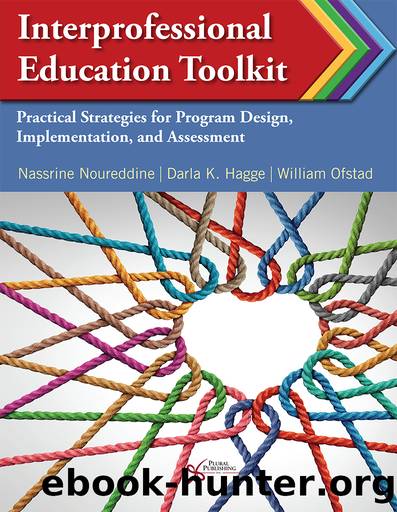Interprofessional Education Toolkit: Practical Strategies for Program Design, Implementation, and Assessment by Nassrine Noureddine;Darla K. Hagge;William Ofstad;

Author:Nassrine Noureddine;Darla K. Hagge;William Ofstad;
Language: eng
Format: epub
Publisher: Plural Publishing Inc.
Published: 2021-02-15T00:00:00+00:00
7
Assessing an IPE Curriculum: An Overview
William Ofstad, Nassrine Noureddine, and Darla K. Hagge
The principal goal of education is to create individuals who are capable of doing new things, not simply of repeating what other generations have done.
âJean Piaget (Educational psychologist, 1896â1981)
ABSTRACT
This chapter introduces a variety of interprofessional education and collaborative practice assessment tools and frameworks. For many reasons, assessment is critical to educators within healthcare professions, but chief among them is how assessment drives growth and meaningful change within the learner. Carefully designed measures and regular performance reflection are transformative for both learners and organizations. Measurement across a variety of outcome types will help to illuminate the key stages of growth, from novice learner to ultimately performing as a fully entrustable interprofessional practitioner and leader.
This chapter introduces why IPE assessment is crucial at all levels. In alignment with best practices, a structured approach is followed for choosing IPE assessment tools organized from a curriculum perspective using backward design (i.e., starting with the end in mind) and the Kirkpatrick Expanded Typology.
KEY DEFINITIONS AND CONCEPTS
Accomplishment Outcomes: Significant work products or performances that transcend normal class requirements and are externally valued or affirmed by an outside expert or client (Beyerlein et al., 2007).
Accreditation: âA formal, independent verification that a program or institution meets established quality standards and is competent to carry out specific conformity assessment tasks. Conformity assessment tasks may include, but are not limited to, testing, inspection, or certificationâ (International Accreditation Service, n.d., para. 1).
Assessment: âAssessment provides feedback on knowledge, skills, attitudes, and work products for the purpose of elevating future performances and learning outcomesâ (Baehr, 2007, p. 441).
Competency Outcomes: The knowledge, skills, and mindsets needed to objectively perform a specific task effectively and efficiently at a defined level of performance (Beyerlein et al., 2007).
Entrustment: Following observation of learner competencies and behaviors, the level of trust given by a preceptor or supervisor to allow independent practice of a desired performance (Obeso et al., 2017).
Evaluation: âEvaluation determines the level of quality of a performance or outcome and enables decision-making based on the level of quality demonstratedâ (Baehr, 2007, p. 441); ârefers to the systematic gathering and interpretation of evidence enabling judgment of effectiveness and value and promoting improvement (Institute of Medicine [IOM], 2015, p. xi).
Experience Outcomes: Interactions, emotions, responsibilities, and shared memories that clarify oneâs position in relation to oneself, a community, or discipline. Experiences are subject focused and often occur in a collective setting (Beyerlein et al., 2007).
Integrated Performance: The synthesis of prior experiences, movement, competencies, and achievements to address a difficult challenge within a strict time frame and set of performance expectations (Beyerlein et al., 2007).
Kirkpatrickâs Expanded Outcomes Typology: A best practice framework for the assessment of formal IPE interventions (Reeves et al., 2015).
Movement Outcomes: Growth in a transferable process or learning skill. Although movement may be subjective, it must document individual change (Beyerlein et al., 2007).
Download
This site does not store any files on its server. We only index and link to content provided by other sites. Please contact the content providers to delete copyright contents if any and email us, we'll remove relevant links or contents immediately.
Application of a Novel Technique for Clinical Evaluation of Nitric Oxide-Induced Free Radical Reactions in ICU Patients by Unknown(693)
Rosenâs Emergency Medicine Concepts and Clinical Practice by Ron Walls; Robert Hockberger; Marianne Gausche-Hill; Timothy B. Erickson; Susan R. Wilcox(571)
Oxidative damage to surfactant protein D in pulmonary diseases by Vitality Starosta1 & Matthias Griese1†(406)
Social Science Perspectives on Global Public Health by Vincent La Placa & Julia Morgan(372)
Constructing Canine Consent; Conceptualising and Adopting a Consent-focused Relationship with Dogs by ERIN JONES(329)
Organic Chemistry: An Acid - Base Approach by MICHAEL SMITH(299)
ADVANCED EMERGENCY CARE AND TRANSPORTATION OF THE SICK AND INJURED by Unknown(270)
Saunders Nursing Drug Handbook 2024 - E-Book by Unknown(262)
Davis's Comprehensive Manual of Laboratory and Diagnostic Tests with Nursing Implications by Unknown(245)
Diagnostic and Statistical Manual of Mental Disorders, Fifth Edition, Text Revision (DSM-5-TR(tm)) by Unknown(245)
Socio-Life Science and the COVID-19 Outbreak : Public Health and Public Policy by Makoto Yano; Fumihiko Matsuda; Anavaj Sakuntabhai; Shigeru Hirota(244)
Human Microanatomy; Cell Tissue and Organ Histology with Celebrity Medical Histories by Stephen A. Stricker(242)
Berne and Levy Physiology E-Book by Unknown(234)
Replacing the Dead by Mie Nakachi;(229)
Handbook of Skin Disease Management by Jiyad Zainab;Flohr Carsten; & Carsten Flohr(228)
Access to Medicines and Vaccines in the South : Coherence of Rules and Policies Applied by the European Union Commission by Stephen Kingah(224)
The Pocket Guide to Sensorimotor Psychotherapy in Context (Norton Series on Interpersonal Neurobiology) by Pat Ogden(218)
Deep Learning and Medical Applications by Unknown(217)
Advances and Technical Standards in Neurosurgery by Unknown(213)
